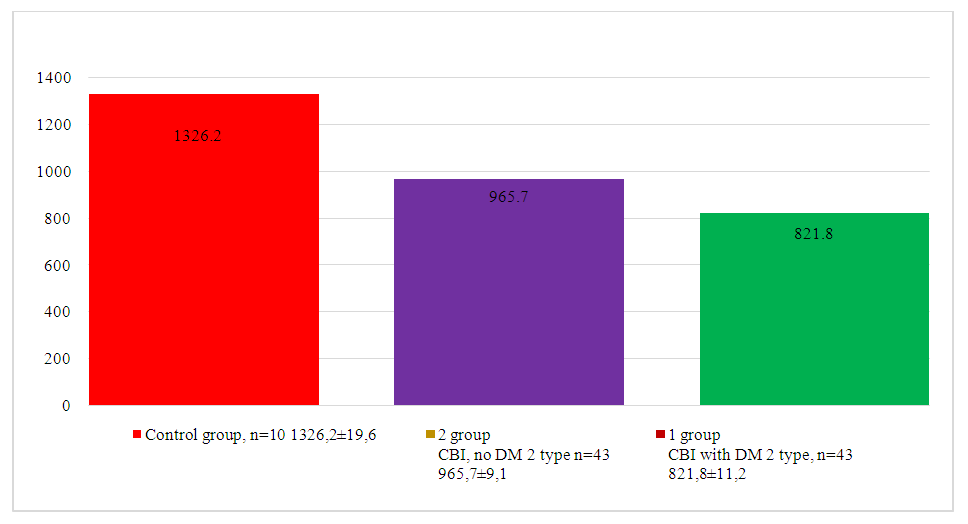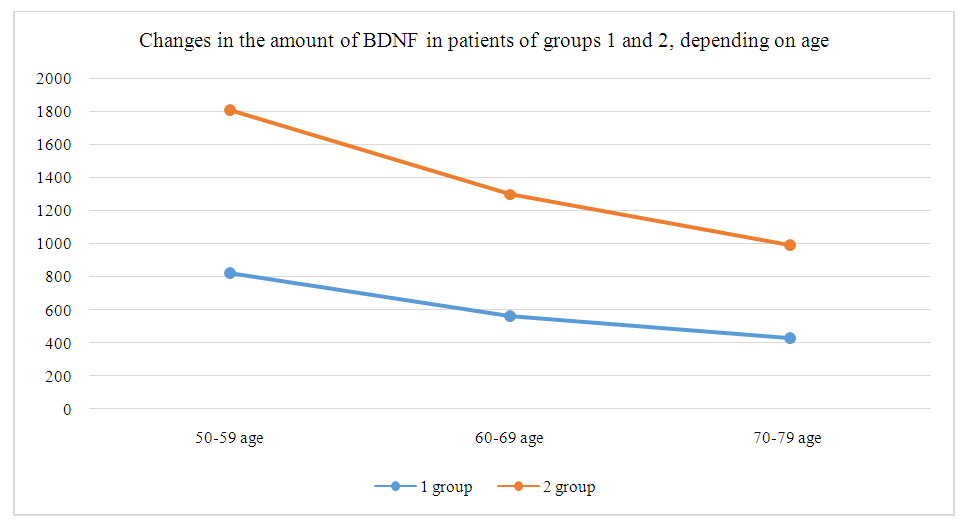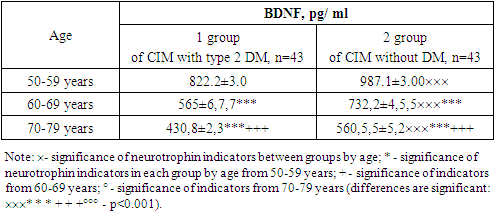-
Paper Information
- Next Paper
- Paper Submission
-
Journal Information
- About This Journal
- Editorial Board
- Current Issue
- Archive
- Author Guidelines
- Contact Us
American Journal of Medicine and Medical Sciences
p-ISSN: 2165-901X e-ISSN: 2165-9036
2023; 13(12): 2026-2028
doi:10.5923/j.ajmms.20231312.44
Received: Oct. 8, 2023; Accepted: Nov. 10, 2023; Published: Dec. 28, 2023

Study of Brain Neurotrophic Factor BDNF in Patients with Chronic Cerebral Ischemia and Type 2 Diabetes Mellitus
Usmanova D. D. 1, Nadjmitdinov O. B. 2
1Docent of Neurology, Pediatric Neurology and Medical Genetics Department of Tashkent Pediatric Medical Institute, Uzbekistan
2Head of the Medical Radiology and Clinic Laboratory Duagnostics, Epidemiology, Sanitation Hygiene Department of Andijan State Medical Institute, Andijan, Uzbekistan
Correspondence to: Usmanova D. D. , Docent of Neurology, Pediatric Neurology and Medical Genetics Department of Tashkent Pediatric Medical Institute, Uzbekistan.
| Email: |  |
Copyright © 2023 The Author(s). Published by Scientific & Academic Publishing.
This work is licensed under the Creative Commons Attribution International License (CC BY).
http://creativecommons.org/licenses/by/4.0/

Brain-derived neurotrophic factor - BDNF is a neurotrophin (NT) that plays important roles in maturation, synaptic communication, neuronal repair and plasticity of the central nervous system (CNS), and also influences the pathology and treatment of neurological diseases. In addition to its fundamental effects on the nervous system, several reports have documented an association between plasma BDNF and systemic or peripheral inflammatory conditions such as acute coronary syndrome and type 2 diabetes.
Keywords: Brain neurotrophin factor, Neurotrophin, Chronic cerebral ischemia, Diabetes mellitus
Cite this paper: Usmanova D. D. , Nadjmitdinov O. B. , Study of Brain Neurotrophic Factor BDNF in Patients with Chronic Cerebral Ischemia and Type 2 Diabetes Mellitus, American Journal of Medicine and Medical Sciences, Vol. 13 No. 12, 2023, pp. 2026-2028. doi: 10.5923/j.ajmms.20231312.44.
1. Relevance
- Diabetes mellitus (DM) type 2 is a complex disease and a serious public health problem worldwide. In pure terms type 2 diabetes is a group of metabolic diseases characterized by chronic hyperglycemia followed by impaired insulin secretion and action. It is believed that genetic and environmental factors are responsible for the development of type 2 diabetes [1]. In addition, it has been observed that type 2 diabetes is associated with inflammation [2,5]. Brain neurotrophin factor (BDNF) is a neurotrophin (NT) that plays an important role in maturation, synaptic communication, neuronal repair, and plasticity of the central nervous system (CNS), and also affects the pathology and treatment of neurological diseases [2,3,7]. In addition to its fundamental effects on the nervous system, it also has an important role in the development of neuropathy. Several reports have documented the association between plasma BDNF and systemic or peripheral inflammatory conditions such as acute coronary syndrome and type 2 diabetes [4]. BDNF has attracted attention due to its possible role in protecting against the progression of type 2 diabetes, as well as cognitive decline in CIM [6]. Some studies suggest that BDNF may be a future target for the development of new antidiabetic therapies. Objective: to study the relationship between the level of BDNF in the blood serum and the cognitive sphere in patients with CIM.
2. Material and Methods of Research
- The quantitative content of brain- derived neurotrophic factor (BDNF) in the blood serum of the studied individuals was studied in 96 individuals, i.e., in 10 of the control group and 43 in group 1 and 43 – 2 in group 2.
3. Research Results
- The results of studying the neurotrophic factor BDNF in the blood serum of 96 subjects showed the following: in the control group, the quantitative content of BDNF was 1326.2,2±19.6, [1203-1407] pg/ml; in 1group 1: BDNF was 821.8,8±11.2 [622.1-1012.4,4] pg/ml, inо 2 group 2: BDNF was It is equal to, 7965.7±9.1, [722.9,9-1199.6,] pg/ml (p<0.05) (Fig. 1).
 | Figure 1. BDNF values in blood serum in patients of the control group, 1 and 2 group in the comparative aspect |
|
 | Figure 2. Indicators of neurotrophic factor BDNF in blood serum in individuals of groups 1 and 2, depending on the age of the patient |
|
4. Conclusions
- An analysis of the comparison of the total content of neurotrophic factor by age category among all the comparison group studied shows that the level of BDNF was significantly higher in the age group of 50-59 years than in the group of people aged 60-69 years (p<0.01) and 70-79 years (p<0.001) Thus, the studied patients CIM patients with type 2 diabetes had low levels of BDNF in theыворотке blood serum.
 Abstract
Abstract Reference
Reference Full-Text PDF
Full-Text PDF Full-text HTML
Full-text HTML
